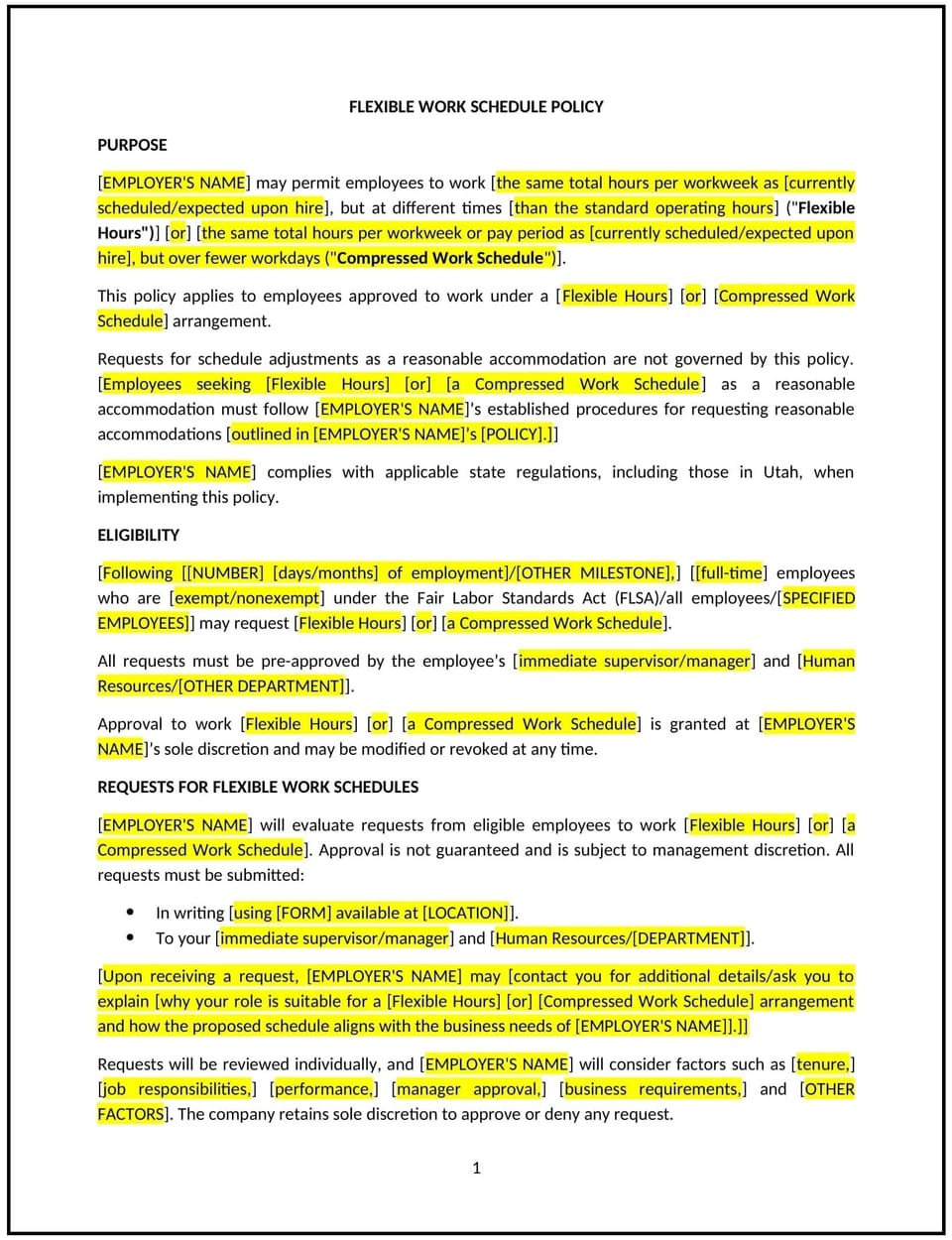Flexible work schedule policy (Utah): Free template

Flexible work schedule policy (Utah)
This flexible work schedule policy is designed to help Utah businesses establish guidelines for offering flexible work arrangements, such as remote work, compressed workweeks, or flexible hours. It outlines eligibility criteria, procedures for requesting flexible schedules, and expectations for maintaining productivity.
By adopting this policy, businesses can support work-life balance, enhance employee satisfaction, and align with general best practices for workplace flexibility.
How to use this flexible work schedule policy (Utah)
- Define flexible work options: Specify the types of flexible schedules available, such as remote work, flextime, or compressed workweeks.
- Establish eligibility criteria: Outline which employees are eligible for flexible schedules, such as full-time staff or those in specific roles.
- Set request procedures: Provide steps for employees to request flexible schedules, including required documentation or approvals.
- Address productivity expectations: Clarify that employees on flexible schedules must maintain their productivity and meet performance standards.
- Monitor compliance: Regularly review flexible work arrangements to ensure they meet business needs and employee expectations.
- Train managers: Educate supervisors on managing flexible work schedules and maintaining team cohesion.
- Review and update: Assess the policy annually to ensure it aligns with evolving business needs and workplace trends.
Benefits of using this flexible work schedule policy (Utah)
This policy offers several advantages for Utah businesses:
- Supports work-life balance: Helps employees manage personal and professional responsibilities more effectively.
- Enhances employee satisfaction: Demonstrates a commitment to flexibility, boosting morale and retention.
- Attracts talent: Provides a competitive benefit that appeals to job seekers.
- Aligns with best practices: Offers a structured approach to managing flexible work arrangements.
- Improves productivity: Allows employees to work during their most productive hours, enhancing overall efficiency.
Tips for using this flexible work schedule policy (Utah)
- Communicate the policy: Share the policy with employees and include it in the employee handbook.
- Provide training: Educate managers on managing flexible work schedules and maintaining team cohesion.
- Monitor compliance: Regularly review flexible work arrangements to ensure they meet business needs.
- Address issues promptly: Take corrective action if flexible schedules negatively impact productivity or team dynamics.
- Update regularly: Assess the policy annually to ensure it aligns with evolving business needs and workplace trends.
Q: How does this policy benefit businesses?
A: By offering flexible work schedules, businesses can support work-life balance, enhance employee satisfaction, and attract top talent.
Q: What types of flexible work options are typically available?
A: Options may include remote work, flextime, compressed workweeks, or job sharing.
Q: How can businesses ensure productivity with flexible schedules?
A: Businesses should set clear performance expectations and regularly review employee output.
Q: What should businesses do if a flexible arrangement isn’t working?
A: Businesses should address the issue promptly, explore alternative arrangements, or revert to a standard schedule if necessary.
Q: How often should businesses review this policy?
A: Businesses should review the policy annually or as needed to ensure it aligns with evolving business needs and workplace trends.
This article contains general legal information and does not contain legal advice. Cobrief is not a law firm or a substitute for an attorney or law firm. The law is complex and changes often. For legal advice, please ask a lawyer.


